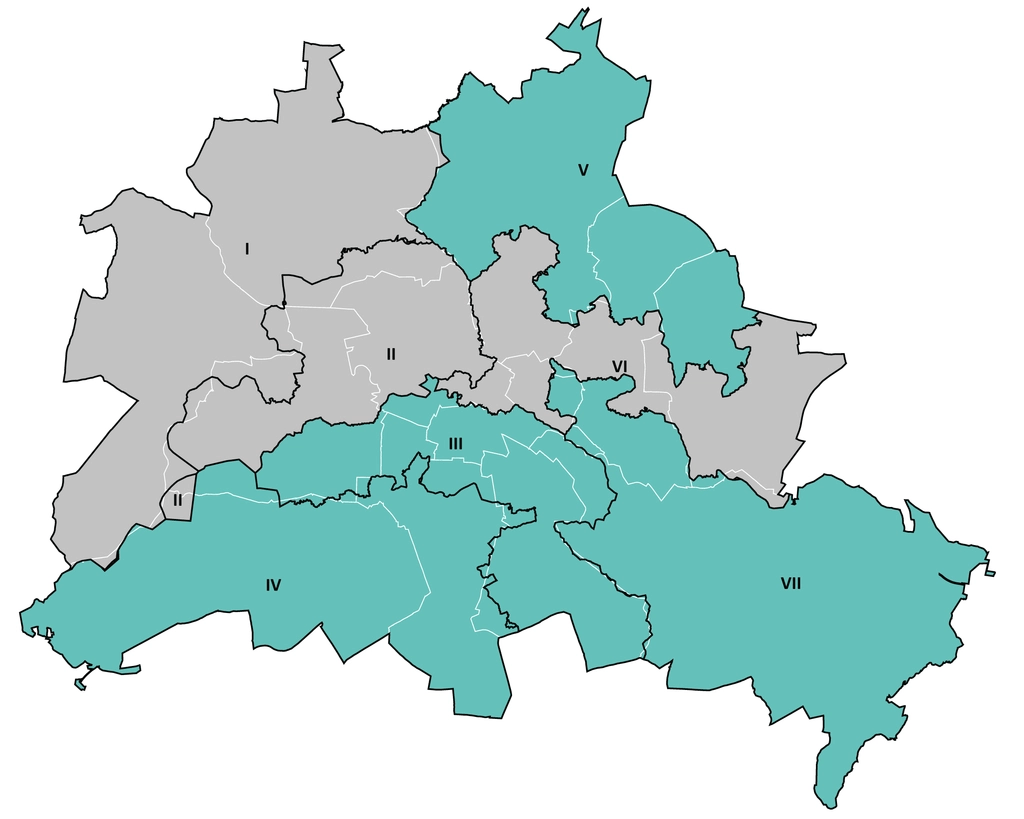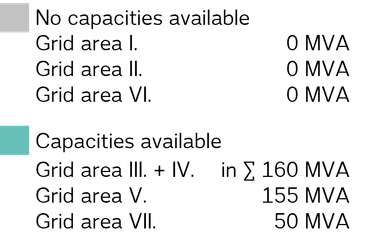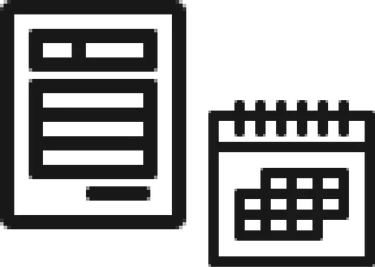Allocation procedure for capacities greater than 3.5 MVA
We have introduced an allocation procedure for the transparent and non-discriminatory allocation of grid connection capacities greater than 3.5 megavolt amperes (MVA).
This allocation procedure (repartition) ensures the limited grid capacities in the medium and high voltage levels in accordance with the principle of equal treatment of connection requests with an output requirement greater than 3.5 MVA.
In the allocation procedure, we issue benefit commitments once a year on 31 July - provided that the complete connection application in accordance with VDE-AR-N 4110 or 4120 was submitted on time between 15 April and 30 June.
Overview and links to the content of this page
Status of the allocation period | Documents on procedure | Information on the procedure | Video of the webinar on the allocation process | Connection advice | Questions and answers
Why did we introduce the allocation procedure and which of our customers does it apply to?
Find out in this video:
Video in German language only.
Allocation period 2025
Customers had the opportunity to submit their binding requests for grid connections with a power requirement greater than 3.5 MVA to us by 30 June 2025.
We will not be able to consider applications received after 30 June 2025 during this allocation period.
Based on the requests received, we will determine by 31 July 2025 which capacities of the total 365 MVA available in Berlin we can make available to which customers. The customers who have participated in the allocation process will be informed directly by us.
Overview of available capacities in the sub-networks


Note
A connection petitioner had submitted applications to the Federal Network Agency for the allocation of connection capacities prior to the application of the repartition procedure and for the suspension of the procedure. The Federal Network Agency rejected these applications.
In the meantime, the petitioner has made use of its option to lodge an appeal with the Düsseldorf Higher Regional Court (OLG). The repartition procedure is therefore still subject to judicial review.
We will provide information on the outcome of the legal proceedings at the OLG in due course.
Documents for the application
Establishment or modification of a connection to the medium-voltage grid with a capacity > 3.5 MVA
We require the following for the establishment or modification of a connection:
- the completed forms E.1, E.2 and possibly E.8 of the VDE AR N 4110*,
- the anticipated power requirement (power balance); if you specify the desired contractual power in kW (active power), we will set this equal to kVA (apparent power) - unless you specify the apparent power value or the cosϕ shift factor,
- a scaled site plan with the local location of the property to be connected. If you already have a suggested location for your transfer station, please enter this and the desired cable route on the property or in the building on the site plan.
Forms TAR medium voltage from appendix E of VDE AR N 4110*
* VDE-AR-N 4110 is part of the VDE regulations and can be purchased from VDE-Verlag.
Establishment or modification of a connection to the high-voltage grid with a capacity > 3.5 MVA
We require the following for the establishment or modification of a connection:
- the completed forms E.1, E.2 and, if applicable, E.6 of VDE AR N 4120,
- a true-to-scale site plan in accordance with form E.4 of VDE-AR-N 4120,
- an overview circuit diagram according to form E.4 of VDE-AR-N 4120,
- the expected power requirement (power balance).
TAR Hochspannung – forms from appendix E of VDE AR N 4120*
Further information
Since 1 January 2015, the VDE-AR-N 4120 has replaced the Transmission Code 2007 as well as the VDN guideline "Renewable Energy Power Plants on the High-voltage Network" (EEG-Anlagen am Hoch- und Höchstspannungsnetz) for 110 kV grid connections.
Information of the VDE on the topic of high-voltage connection
Note
Since May 2016, the "Commission Regulation (EU) 2016/631 of 14 April 2016 establishing a network code on requirements for grid connection of Generators" has applied. At present, this is being transposed into national law by the relevant bodies, such as the VDE-FNN, and we expect an amendment to the technical connection regulations (TAR).*
* The VDE-AR-N 4120 forms part of the VDE regulations and can be purchased from VDE Verlag GmbH.
All documents in German language only.
Contract documents and technical documentation
Information on contract documents and technical documentation can be found on our page connection medium and high voltage.
Information on the allocation procedure
In order to continue to ensure the principle of equal treatment of connection requests with an output requirement of more than 3.5 MVA, the limited grid capacities will be allocated proportionately and equally in the repartition procedure. This procedure ensures the highest possible degree of transparency and fairness based on the statutory connection regulations.
The procedure provides for an equal, fair and non-discriminatory distribution of available capacities among the connection customers participating in the procedure, once a year.
We have summarised the process flow for capacity allocation according to the following allocation procedure. We will announce any changes to this procedure here in good time before they come into force.
Requests for grid connections with a capacity of less than 3.5 MVA, which include all low-voltage connections and almost all medium-voltage connections, will continue to be processed according to the previous procedure.
Brief overview of process steps
-

Capacity determination
The available capacities for the upcoming allocation period will be determined and published by 14 April at the latest.
-

Participation in the procedure / Binding request
Binding requests for connection with complete documentation can be submitted in the period 15 April to 30 June, 23:59:59 (CET).
-

Checking requests and allocation
Complete and timely connection requests will be checked and the available capacity allocated to all requests in equal shares, and the applicants will be informed by 31 July.
-

Connection concept and offer
A connection concept with an implementation plan will be created for each request based on the allocated service. The applicant will receive a binding offer by 31 January at the latest.
-

Checking / acceptance of the connection offer
The offer will be reviewed by the applicant and must be accepted within the period of validity.
The procedure in detail - step-by-step explanation
1. Capacity determination
- We shall carry out a capacity assessment by the end of the first quarter of a year in order to determine the available capacities for the upcoming round of proceedings. The data available to us for grid expansion and connection planning and the actual occurring load development will be taken into account.
- The result of the capacity assessment for the coming allocation period will be published on 14 April of each year, and no later than on the last working day before the start of the participation procedure.
- The publication is made by naming at least one output value, e.g. 50 MVA, and by a supplementary overview map with the Berlin area for a power allocation (topogram).
2. Participation in the procedure / Binding request
- The participation procedure starts on 15 April each year.
- Binding requests for connection can be submitted between 15 April and 30 June of a year. Only complete and plausible enquiries received by 30 June of the year will be considered in the further procedure. We have summarised the conditions of participation and the required documents below.
- A request must be submitted for a new connection or an extension of an existing connection for a (total) power > 3.5 MVA.
- The complete connection request must be sent by email to [email protected].
The time stamp for the receipt of the e-mail (no later than 30 June, 23:59:59 CET) is relevant for determining the timely receipt of a request. Connection requests received late will not be considered in the further process flow.
3. Checking of requests and allocation (repartition)
- All binding connection requests received within the enquiry period and thus in good time will be checked.
- Once all the binding connection requests have been checked, the available capacities will be allocated proportionally to the successful connection requests, up to the maximum of the requested capacity.
- Applicants will be informed in writing by 31 July of the capacity that has been allocated to them.
4. Connection concept and offer
- After allocating the service to a connection enquiry, we will start preparing a grid connection concept that includes a cost calculation and framework scheduling.
- After completion, we will prepare and submit a binding offer by 31 January of the following year at the latest to establish a grid connection.
- The offer will be sent in writing.
5. Checking / acceptance of the connection offer
- Parties who have requested a connection will receive a binding offer for the allocated service.
- The offer will be binding for two months from the date of the written offer.
- If the offer is accepted within this period, the procedure for establishing the connection will begin.
- If the offer is not accepted or not accepted in due time, the offer will cease to be valid. The capacity previously allocated to the connection applicant will expire and be made available again to all connection petitioners in the following procedure period, subject to the capacity determination to be carried out upstream.
Note on the previous procedure
Until 2024, power requests for medium and high-voltage grid connections greater than 3.5 MVA were processed in the order in which they were received, known as the first-come, first-served principle, and the requested output was allocated to the major customers.
There was always sufficient capacity available in our distribution grid for the few annual requests.
Since then, however, the situation has changed fundamentally. The number of connection enquiries over 3.5 MVA has increased considerably and exceeds the available capacity in our grid.
Webinar on the new allocation procedure
In December 2024, we presented the new allocation procedure to our customers in a webinar. Dr. Anke Reimers and Gerhard Bressler explained why we introduced the procedure and how it works.
In the video, you can use a calculation model to understand how the available grid connection capacity is distributed to customers with high demand.
The video and the presentation of the webinar in German language only.
Presentation webinar allocation procedure
Hint: This presentation has been updated and differs in a few details from the presentation shown in the webinar.
General, non-binding grid connection advice
Interested parties can contact us at any time as part of a grid connection consultation and discuss their projects or drafts for connection applications with us.
A preliminary review does not constitute a substantive assessment or prioritization of the application in the allocation procedure.
Please use the mailbox for inquiries regarding grid connection advice
[email protected].
Questions and answers
These questions and answers relating to the repair procedure are purely informative and do not replace the conditions of participation or the individual examination of individual applications by Stromnetz Berlin.
Different regulations may apply to individual cases and specific projects.
Further information can be found in our conditions of participation. (In German language only)
Procedure
What is the aim of the repartition procedure, and why has it been introduced?
The aim of the repartition procedure is to distribute the limited grid capacities in Berlin in a transparent, non-discriminatory and fair manner. Its introduction enables us to ensure the security of supply and support the energy transition. Information on the procedure can be found here on this website and in the conditions of participation.
When does the new regulation come into force?
The regulation applies retroactively from 1 January 2024.
How does this procedure work?
Previously, the principle of "first come, first served" applied to enquiries from very large customers for very large grid connections with a connected load of more than 3.5 megawatts each, regardless of the size of the enquiry. We do not believe that this is fair in the long term, and so we share the available power equally among the requests received by a specific deadline, regardless of the desired output.
We have compiled the following three examples in the conditions of participation to explain the procedure (petitioner = applicant).
The figures stated refer to the information in the conditions of participation.
Example 1
Output capacity determined and published for the respective grid area in accordance with item 1: 120 MVA
1st petitioner: Request for 5 MVA without accepted partial output
2nd petitioner: Request for 10 MVA with accepted partial output ≥ 5 MVA
3rd petitioner: Request for 100 MVA without accepted partial output
4th petitioner: Request for 80 MVA with accepted partial output ≥ 25 MVA
5th petitioner: Request for 65 MVA with accepted partial output ≥ 50 MVA
Power capacity allocated in accordance with item 3:
- Level 1:
Total requested connected load (260 MVA) > published output capacity (120 MVA), i.e. repartition required. - Level 2:
Each petitioner initially accounts for a partial output of 24 MVA (120 MVA : 5) - Level 3:
The first petitioner’s output request is lower. The petitioner is allocated 5 MVA. The remaining output of 19 MVA is shared among the other petitioners. The second petitioner’s output request is also lower, and this petitionier is allocated 10 MVA. The remaining output of 14 MVA is shared among the other petitioners. Each of the remaining three petitioners - 3, 4 and 5 - will therefore receive 35 MVA
([24 MVA + 24 MVA + 24 MVA + 19 MVA + 14 MVA] : 3). - Level 4:
The third petitioner’s request is not considered because the acceptance of partial output was refused. The remaining output of 35 MVA can be shared between the other two petitioners. - Level 5:
This means 105 MVA are available for petitioners 4 and 5; each will therefore receive a partial output of 52.5 MVA (105 MVA : 2)
Example 2
Output capacity determined and published for the respective grid area in accordance with item 1: 130 MVA
1st petitioner: Request for 10 MVA without accepted partial output
2nd petitioner: Request for 30 MVA with accepted partial output ≥ 25 MVA
3rd petitioner: Request for 100 MVA without accepted partial output
4th petitioner: Enquiry for 40 MVA with accepted partial output ≥ 20 MVA
5th petitioner: Enquiry for 60 MVA with accepted partial output ≥ 50 MVA
Power capacity allocated in accordance with item 3:
- Level 1:
Total requested connected load (240 MVA) > published power capacity (130 MVA), i.e. repartition required. - Level 2:
Each petitioner initially accounts for a partial output of 26 MVA (130 MVA : 5) - Level 3:
The first petitioner’s request for output is lower. The petitioner is allocated 10 MVA. The remaining output of 16 MVA is shared among the other petitioners. 120 MVA remain, so each of the four petitioners - 2, 3, 4 and 5 - will receive 30 MVA The second petitioner will therefore receive the requested capacity of 30 MVA, leaving 90 MVA. - Level 4:
The third petitioner’s request is not considered because the acceptance of partial output was refused. That petitioner’s remaining output of 30 MVA can be shared among the other petitioners.
- Level 5:
This means that 90 MVA are available for petitioners 4 and 5, i.e. 45 MVA each. The fourth petitioner’s request is lower, and that petitioner is allocated 40 MVA. This petitioner’s remaining output of 5 MVA will be allocated to petitioner 5, meaning that petitioner receives a total of 50 MVA.
Example 3
Output capacity determined and published for the respective grid area in accordance with item 1: 130 MVA
1st petitioner: Request for 10 MVA without accepted partial output
2nd petitioner: Request for 30 MVA with accepted partial output ≥ 25 MVA
3rd petitioner: Request for 100 MVA without accepted partial output
4th petitioner: Request for 60 MVA with accepted partial output ≥ 40 MVA
5th petitioner: Request for 80 MVA with accepted partial output ≥ 70 MVA
Power capacity allocated in accordance with item 3:
- Level 1:
Total requested connected load (280 MVA) > published output capacity
(130 MVA), i.e. repartition required. - Level 2:
Each petitioner initially receives a partial output of 26 MVA (130 MVA : 5) - Level 3:
The first petitioner’s request for power is lower. The petitioner is allocated 10 MVA. The remaining output of 16 MVA is shared among the other petitioners. 120 MVA remain, so each of the four petitioners - 2, 3, 4 and 5 - will receive 30 MVA The second petitioner is therefore allocated the requested capacity of 30 MVA, leaving 90 MVA. - Level 4:
The third petitioner’s request is not considered because the acceptance of partial output was refused. This petitioner’s remaining output of 30 MVA can be shared among the other petitioners. - Level 5:
This means that 90 MVA are available for petitioners 4 and 5, i.e. 45 MVA each. The second petitioner is allocated an output of 45 MVA. The fifth petitioner is not allocated an output because their stated partial output is higher than the available output. Of the remaining share (of 45 MVA), a further 15 MVA are allocated to petitioner 4, who thus achieves the requested capacity of 60 MVA. The remaining 30 MVA will be considered in the bidding process for the following year.
Who is authorised to submit applications?
All potential connection customers who have a requirement for a grid connection capacity > 3.5 MVA can submit applications.
Applications must be submitted on a property-by-property basis in accordance with enclosure 1 of the conditions of participation. Applications must contain all the required information and documents listed in enclosure 1 of the conditions of participation (including application documents in accordance with VDE-AR-N 4110 or 4120, site plan, overview circuit diagram, power balance, etc.), and must be received by 23:59:59 on the day specified in Section 2 a. by the e-mail address [email protected].
Further information on the application requirements and applicable deadlines can be found in the conditions of participation.
From what output does the procedure apply?
The procedure applies to requests for the provision of electrical services in a capacity > 3.5 MVA.
Are existing customers also affected by the procedure?
Yes, the procedure also applies to existing customers who increase their power consumption - if a total connected load of 3.5 MVA is exceeded. (Example: existing connection of 2.8 MVA + desired power increase of 1 MVA = total connected load of 3.8 MVA = participation in the repartition procedure.)
Participation and application
What needs to be submitted and when?
We have summarised the detailed structure of the procedure and all the relevant dates and periods further up on the website. You will also find the conditions of participation and the additional attachments (application, landowner's declaration) for a connection enquiry there.
What documents are required for participation?
We have summarised the detailed structure of the procedure and all the relevant dates and periods further up on the website. You will also find the conditions of participation (enclosure 1) and the additional attachments (enclosure 2, landowner's declaration) there. This provides details of all the documents that are relevant to the application for your connection enquiry.
Is it necessary to submit a building permit or a positive preliminary building permit when submitting the application?
If an undeveloped property is to be connected to Stromnetz Berlin's distribution grid for the first time, the connection customer must provide suitable proof of their authorisation under public law to build on the respective property (e.g. a copy of the building permit or the application for a building permit) if the development requires authorisation under public law. If the connection customer is not the owner of the property, they must submit a declaration from the property owner in accordance with the sample in enclosure 2 or an extract from the land register showing that a priority notice of conveyance has been entered in their favour for the property in question. All the information on the application procedure and the requirements can be found in the conditions of participation.
Can a specified type of use be changed in the course of the procedure?
Subsequent changes to the type of use are not possible across the board. By submitting the application, the applicant assures that they require the requested service for the supply of their own consumption facilities on a permanent basis. A change in the type of use must therefore be checked on a case-by-case basis, as this can have an impact on the power balance and the consumption parameters. We recommend contacting us directly to discuss individual cases.
By when must applications have been submitted?
From 2025, binding requests for connection with complete documentation can be submitted in the period 15 April to 30 June, 23:59:59 (CET). If 30 June is a Saturday, Sunday or public holiday in Berlin, the request can be submitted by the end of the following working day.
What deadlines apply after the allocation of capacities?
The deadlines for accepting an offer are set out in the conditions of participation and shown in the process overview on our website. The binding offer period is two months.
Can I submit a new enquiry in the year following an allocation?
Yes, you can also participate again in the following year if you need additional capacity. As before, the new request must be made between 15 April and 30 June of each year. Information on the process and deadlines can be found on our website and in the conditions of participation.
When and how will I find out whether my application has been considered?
Complete requests for connection can be submitted in the period 15 April to 30 June, 23:59:59 (CET). Complete and timely connection requests will be checked and the available capacity allocated to all requests in equal shares. Once the allocation of capacities has been completed, the applicants will be informed of the results in writing by 31 July.
Assessment and allocation
What criteria are used to assess requests and allocate capacities?
As part of the application process, we check the requests for completeness. The required application documents are listed in appendix 1, enclosure A of the conditions of participation. The allocation of the available power is divided equally ("per capita") irrespective of the desired output. In the conditions of participation, we have compiled a number of examples to explain the procedure. After completion of the application review and allocation of the available capacities, the applicants will be informed in writing by 31 July.
The webinar on the allocation procedure also shows you how the procedure works and the criteria used to allocate capacity.
How can we be sure that the procedure is transparent and non-discriminatory?
We have described all the steps transparently and comprehensibly in the conditions of participation. No distinction is made between customer groups. The procedure was agreed with the Federal Network Agency prior to its introduction.
Is the allocation made per network area or for the entire city?
The repartition is carried out for the capacities - if available - in the respective grid areas, not for the entire capacity of Berlin. The Berlin distribution grid is divided into seven grid areas. Once a year, we determine the capacities for connection services currently available in the respective grid area and those that will be available in the foreseeable future. To determine these capacities, we consider the following ten calendar years in each case. We use a map (topogram) to schematically visualise the geographical location of the available capacities and those that will be available in the foreseeable future.
Will requests with unallocated power have a higher priority in the next round?
No, there is no automatic prioritisation for the next round. All requests must be resubmitted in full each allocation period and will be assessed on an equal footing.
What capacities are likely to be available in the next rounds of proceedings?
The capacities to be distributed are determined once a year and published on the Stromnetz Berlin website. An advance prognosis is not possible. For up-to-date information, we recommend regularly checking the website. Further information on the determination and publication of the capacities to be distributed can be found in the conditions of participation.
Is critical infrastructure (e.g. transport, security) prioritised?
As a grid operator, Stromnetz Berlin is legally obliged to act in a non-discriminatory manner. No customer groups are favoured or disadvantaged. The repartition procedure was developed with the aim of ensuring a transparent and fair distribution of grid capacities. Allocation is based on clear and objective criteria.
Projects and special cases
Can an allocated partial capacity be accumulated to reach the required total capacity?
It is generally possible to participate in several allocation rounds in order to accumulate the desired total capacity. However, in order to prevent speculative reservations, the completeness of the information is comprehensively checked as part of the application process. The required application documents are listed in appendix 1, enclosure A of the conditions of participation. This includes detailed information on implementation planning, the commissioning date and the track record to ensure that the project is actually realised.
With each enquiry, connection customers also confirm that they require the requested service for the provision of their own consumption facilities (also in the form of self-supply) on a permanent basis, i.e. not just for a short, temporary period.
If it turns out that the information was incorrect, we reserve the right to take legal action, e.g. also in the form of extraordinary cancellation of the contract. In this way, we want to ensure that capacities are utilised efficiently and that all connection customers are given a fair chance to access the resources.
How are large projects such as data centres, charging infrastructure or new-build districts taken into account?
The repartition procedure does not favour or discriminate against any customer groups. Nevertheless, the limited capacities make it necessary for major connection customers in particular to organise their projects flexibly by planning for the risk of staggered allocation.
The repartition procedure does not prioritise the complete coverage of individual major projects, but leads to a fair distribution of the available capacities. A gradual expansion of the grid connection should therefore be planned from the outset during project realisation. This is taken into account by the option of specifying a minimum output in the repartition procedure, with higher output commitments up to the total desired output also being possible.
The conditions of participation contain practical examples that illustrate this.
How is the connection interpreted in the event that only a partial service is allocated to a connection customer?
If only a partial capacity is allocated, the requested grid connection will be designed for the total connection capacity originally applied for (insofar as this is technically feasible), as the connection customer has the option of being allocated further capacity in subsequent years as part of the repartition procedure.
How will staggered requests be handled (e.g. 20 MVA now, 80 MVA later)?
The requirements of the repartition procedure makes staggered requests appear sensible. The limited capacities and pro rata allocation of these capacities to the requests received in a given year require applicants to plan ahead.
Applicants can request capacities in stages, but must submit a new request each year to secure additional capacities.
However, it is also perfectly permissible for customers to request the full capacity if their plans are within our ten-year horizon.
Specifying a minimum output can be particularly helpful here, as it equates to a gradual allocation.
It should also be taken into account that future higher outputs may require a different dimensioning of the grid connection, which will trigger new investment costs.
Can a grid connection be divided into smaller units (< 3.5 MVA) in order to bypass the procedure?
No. Applications must be submitted on a property-by-property basis in accordance with enclosure 1 of the conditions of participation. As a general rule, each connection customer will only receive one grid connection per property.
Does the procedure also apply to feeders and battery storage systems?
The repartition procedure is designed primarily for the distribution of connection capacities. Pure feed-in systems are generally not affected, provided that the consumption of these systems does not exceed 3.5 MVA. Storage systems must be registered via the repartitioning procedure if their requirement is > 3.5 MVA.
Can I go into self-supply (stand-alone grid) if my enquiry is not considered?
Self-supply via a stand-alone grid is generally possible and does not require connection to the public distribution grid. However, it is subject to the legal requirements of the Energy Industry Act (EnWG) and requires extensive technical and regulatory measures, including any necessary authorisations.
Future prospects and further development
How long is the repartition procedure expected to remain in place?
The procedure applies indefinitely and will be maintained as long as the requests exceed the existing and foreseeable service capacities. The long-term outlook for grid capacity depends heavily on the development of electricity demand, the expansion of the grid infrastructure and the energy transition. Stromnetz Berlin is constantly working to improve the grid situation through investments and technological innovations.
What network capacities are you expecting for the next few years?
We determine the available capacities annually and publish them on our website. An advance prognosis is not possible. For up-to-date information, we recommend regularly checking the website. Further information on the determination and publication of the capacities to be distributed can be found in the conditions of participation.
How is Stromnetz Berlin dealing with the challenges of the energy transition?
The demand for electricity in Berlin is constantly growing. We have a very long-term plan for this that recognises and incorporates all the requirements at the earliest possible stage. Stromnetz Berlin is constantly working to improve the grid situation through investments and technological innovations. The repartitioning process is a tool for structuring this part of the energy transition in a sensible, constructive and practicable way.
What significance does the procedure have for the realisation of major projects in Berlin?
Major projects such as data centres or electrical heat generation plants with high connected loads must gradually adapt to the available capacities if the project developers or operators want to realise the project in Berlin. This can be achieved by staggering the planning of connection services over several years.
Stromnetz Berlin is working on expanding its grid capacities in the long term in order to support such projects as well as possible. However, the allocation currently remains limited.
Legal and economic aspects
Is the procedure legally sound?
Non-discriminatory procedures for dealing with shortages are the first-come, first-served principle (based on the time of receipt of applications), the lottery procedure, and the allocation procedure (repartitioning) that we have now introduced.
The repartition procedure is already being introduced by other network operators with a large number of very large connection requests as a replacement for the first-come, first-served procedure.
The procedure had already been presented to the Federal Network Agency prior to its introduction.
How do we ensure that the obligation for non-discriminatory supply is complied with?
Allocation is based on objective, transparent criteria that result from the conditions of participation.
Is capacity allocation subject to political influence?
The repartition procedure was developed with the aim of ensuring a transparent and fair distribution of grid capacities. Allocation is based on clear and objective criteria with no political influence. As a grid operator, Stromnetz Berlin is legally obliged to act in a non-discriminatory manner.
As a natural monopoly, isn't there an obligation for customers to connect to the grid?
There is a connection obligation for low-voltage grid connections up to 1,000 volts, i.e. house connections, heat pumps, charging points for electric vehicles, etc. At higher voltage levels, grid operators can organise the connection procedure differently.
Is there sufficient capacity for connecting buildings, solar systems, heat pumps and e-charging points?
Yes, there is and will continue to be a sufficient electricity and grid capacity in Berlin for all household and commercial customers and also for the grid connection of solar systems, heat pumps and wallboxes in the coming years.
Grid capacity is also available for larger grid connections (> 3.5 MVA). However, in future this capacity will be distributed proportionately to the individual grid connection requests. This applies, for example, to factories/plants in the manufacturing industry, large electrolysers and battery storage facilities or large commercial data centres.
